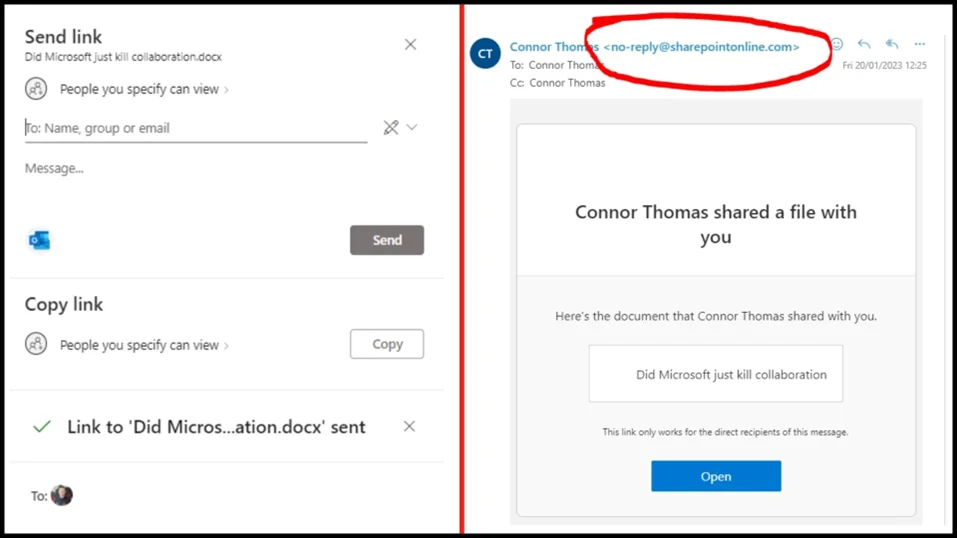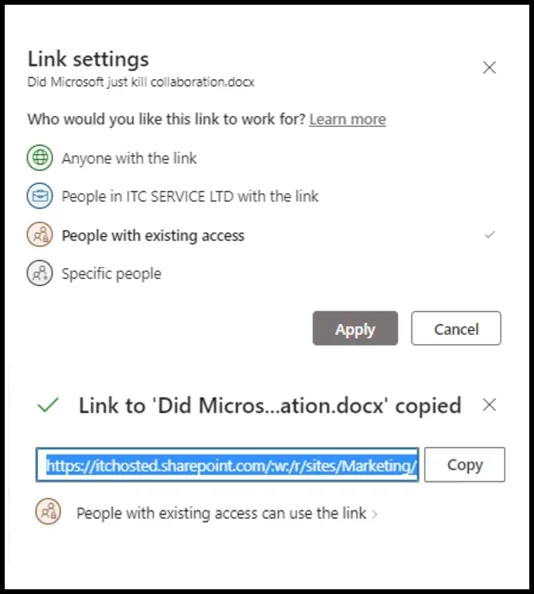Microsoft has been the epicentre of many major IT developments since the release of Windows and the Microsoft product suite. Many businesses and their users depend on collaborative-focused applications, such as Word, OneDrive, Outlook and of course, SharePoint.
SharePoint allows users to create ‘sites’ where important company files and resources can be stored and shared securely in the cloud. Microsoft’s USP is collaboration through technology.
So why have they made a major change that could kill SharePoints file sharing capabilities?
ITC Service have leveraged Microsoft services for a year. Our engineers, managers and even directors practice what they preach, using tools like SharePoint for our own internal processes. It was quite a surprise when Christopher Potts, our Technical Director, noticed that the Microsoft SharePoint file-sharing feature we all know and use had a major glitch: Microsoft SharePoint file shares are now sent from a no-reply@sharepointonline.com email.
This has resulted in the emails being picked up by spam filters and therefore never delivered to the recipients. This is a huge, potentially global issue that will be affecting thousands of businesses right now
So why aren’t we hearing more about it, and what should we do about it?
The Problem: SharePoint notifications are now sent from no-reply@sharepointonline.com
No Reply is an email address that is commonly used to deliver outbound marketing emails, also known as ‘bulk send emails’. Spam filters, especially advanced business email filtering services will notice that the sender is considered a ‘bulk’ email address, and filter those out accordingly to either spam, or delete them completely! Any business that depends on industry-grade cloud applications like SharePoint most likely will have advanced filtering in their product stack.
Now, whenever you share a file to an email from Microsoft SharePoint directly, the email will be sent from noreply@microsoft.co.uk email address and will likely go to spam. This not only hinders collaboration but could affect essential business processes.

This change was made for ITC Service subtly in December and noticed by our technical director shortly after. ITC Service since raised tickets with Microsoft and our reseller who pointed us to this article ‘information about changes to the address that is used to send notification email messages from SharePoint’. They also informed us that Microsoft are intending on returning to sending SharePoint shares from individual users. This feature is currently in ‘general release’, which conflicts with what ITC Service and our customers are experiencing.
The new best way to share a file from SharePoint.
Although we are seeing this problem start to occur more frequently, it may be that it is not affecting your business quite yet, but it might. As it stands, we don’t advise our customers to use the standard sharing methods when sending files directly from SharePoint. Instead, we recommend you copy a link directly from SharePoint, and then send this link separately in an email. This will ensure the deliverability of the SharePoint file. To share a link to a SharePoint file, follow the steps listed below:
1) Navigate to the SharePoint file
2) Right-click and select ‘copy link’
3) Once there you will have the option of copying the link, but it’s important you set the correct permissions first. Underneath the link you will see ‘People with existing access can use the link’. Select this and then set the correct permissions on the share. This works in the same way as the usual sharing method.

4) Send the copied link in an email or a team’s message to the recipient.
Should you have any issues with file sharing and need some assistance. Give our service desk a call on 0191 416 2002 and we will be more than happy to help.
How Microsoft SharePoint’s file sharing might change in the coming months
Microsoft’s documentation on the problem listed in this article is lacking and contradictory. This means we ultimately have no idea what will happen next. We can only share what we see and experience. Currently, we are seeing this change is starting to affect some UK businesses. If it trends in the way we expect, this could cause huge problems where Microsoft may be forced to revert back to the original sharing features. We will be following this closely over the next few months, and may release further articles as the situation develops.
Do you want to improve your business’s communications and collaboration abilities? Speak to us! With over 16 years of experience working on the frontline of business IT support, we’ve seen it all! Free your business of IT troubles today and get in touch!








